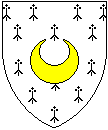
There are relatively few colours used in heraldry. They derive from the use of paints and pigments, metals and furs. There is a general rule that metal should not appear directly on top of metal, nor colour on colour. The metals (gold and silver) would probably originally have been just that: parts of the shield decorated with gold and silver foil, or the surcoat decorated with cloth of gold or silver for the kings and nobles. Certainly in early manuscripts the illustrations use gold and silver leaf or foil; often the silver has tarnished and blackened whereas the gold still shines brightly. On paper they are usually shown as yellow and white respectively.
There are two metals used in heraldry, or (gold) and argent (silver). Although these are normally shown as yellow and white respectively, one should not forget that really they should be shiny and metallic.
There are five colours and three “stains” used, of which the first three are common, the fourth (green) is unusual, and the rest are rare, at least in English heraldry. They are:
In addition, objects can be shown in their natural colours; this is termed proper and is particularly common for representations of plants such as trees, some animals and people.
There are two basic forms of furs, each with different colour-ways. The first is ermine, the second vair.
Ermine in its original form is the winter pelt of the stoat, an animal which turns all white except for the tip of its tail. The fur was (and is) prized and worn as decoration on robes. It was commonly used in heraldry, e.g. Richmond: Ermine a crescent or.
The same pattern is used in four different colours, only the first of which is at all common:
Vair was originally formed from the pelts of squirrels joined together so that the white underside and blue-grey back-fur alternated. It is now always shown as a conventional pattern of alternating white and blue roughly shield-shaped sections. 
The same pattern can be shown in other colours, when it is known as vairy, and the colours must be specified, e.g.
Ferrers, Vairy or and gules.
If the skins are joined point-to-point with the same colour this is termed counter-vair.
There are other rare versions of vair, and one unusual one known as potent (crutch-shaped).
Similarly one can have counter-potent.
Back to the Glossary Contents.
© Gill Smith 1997